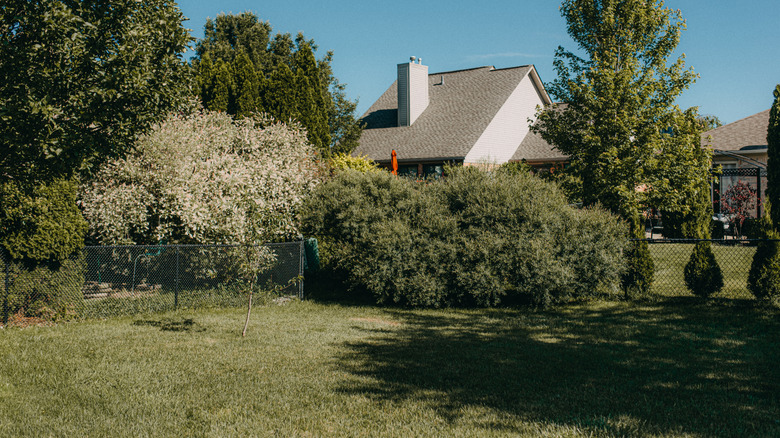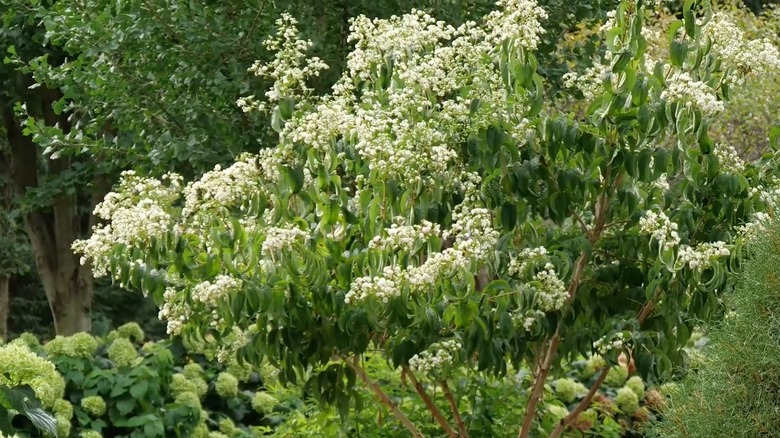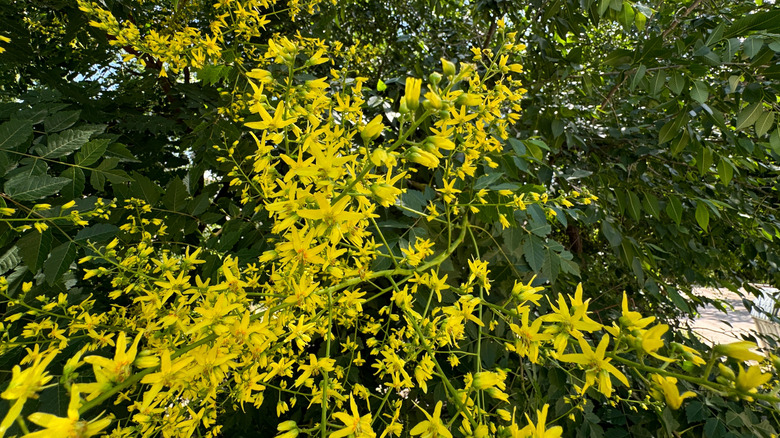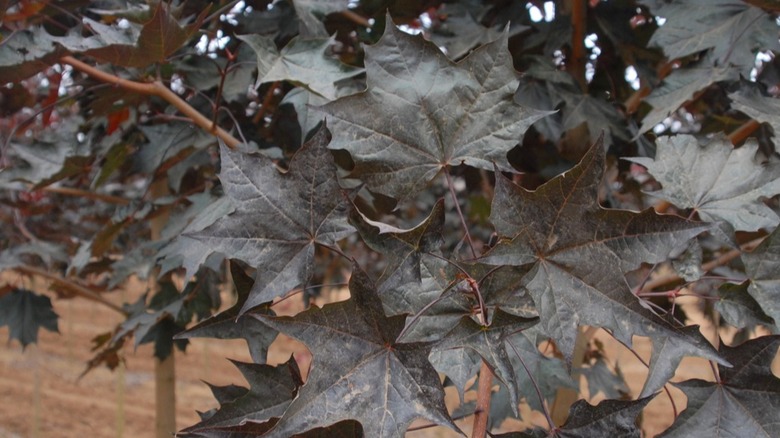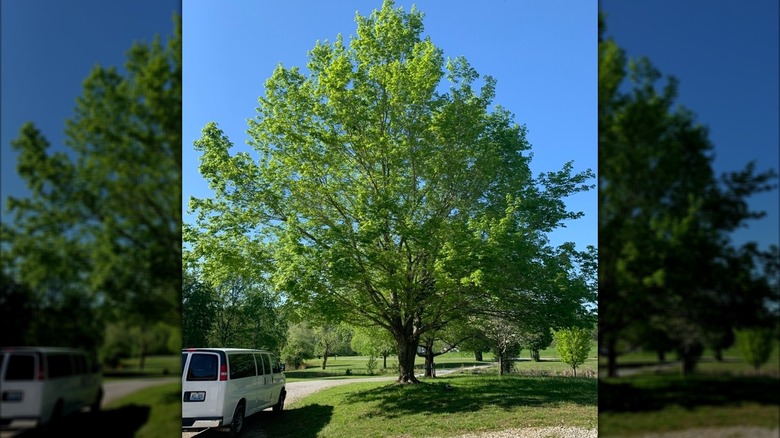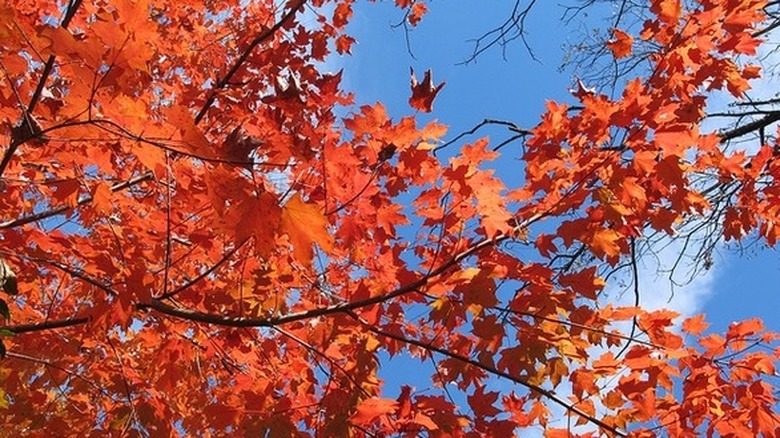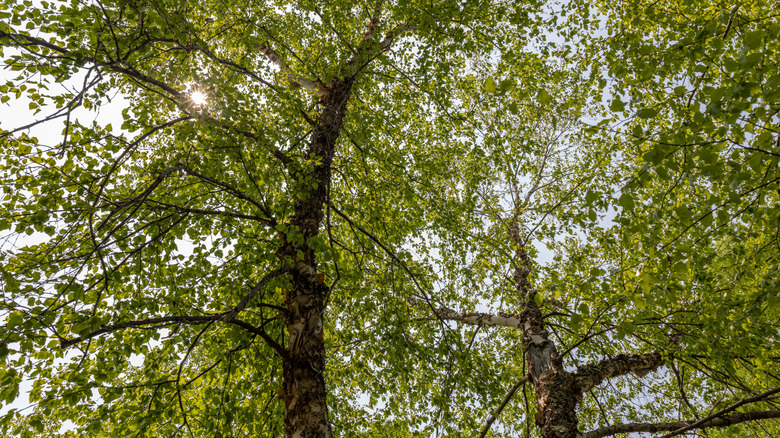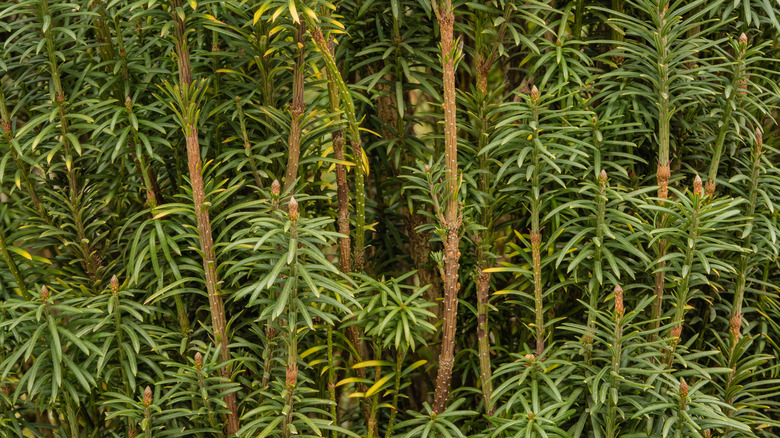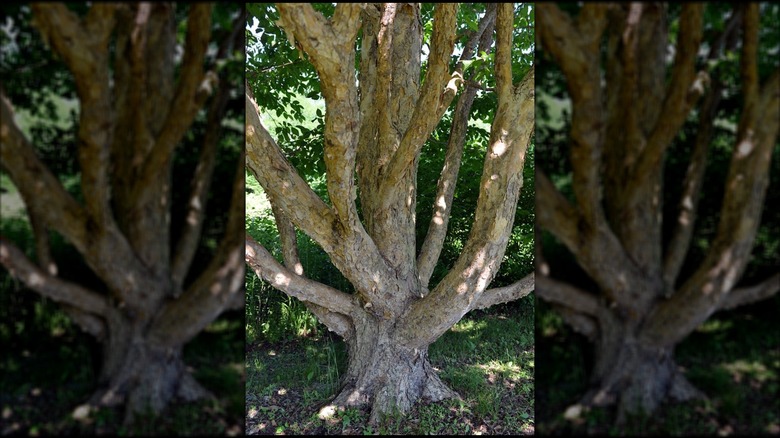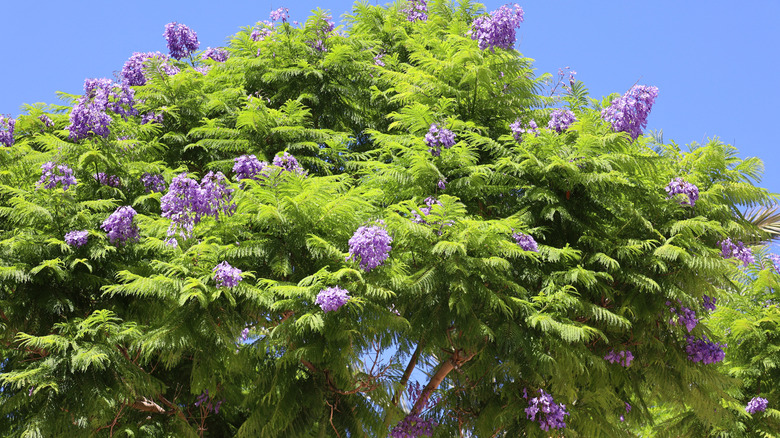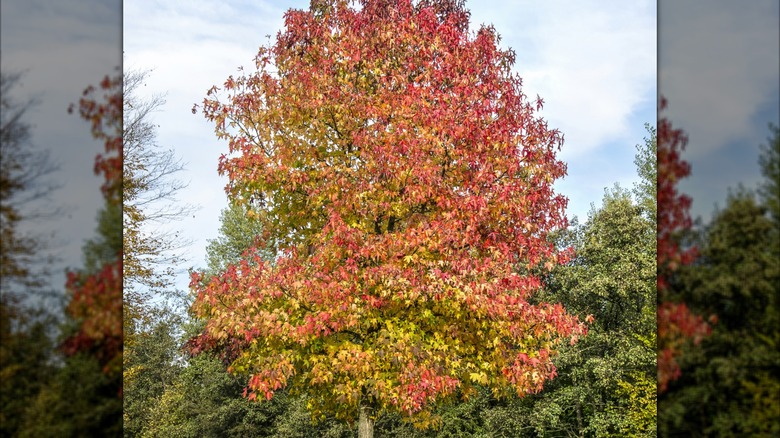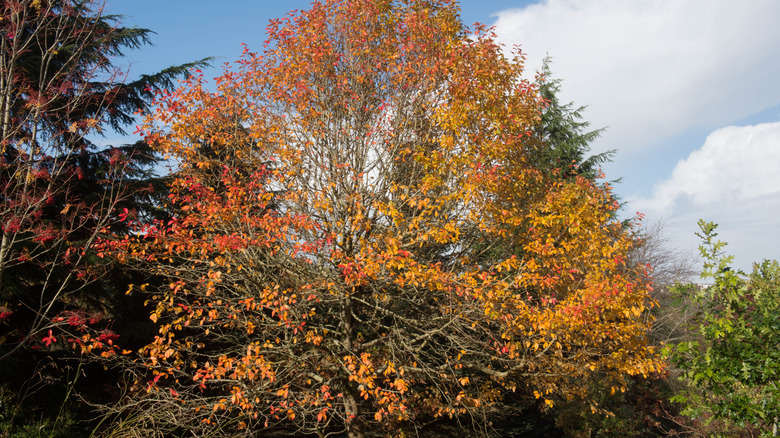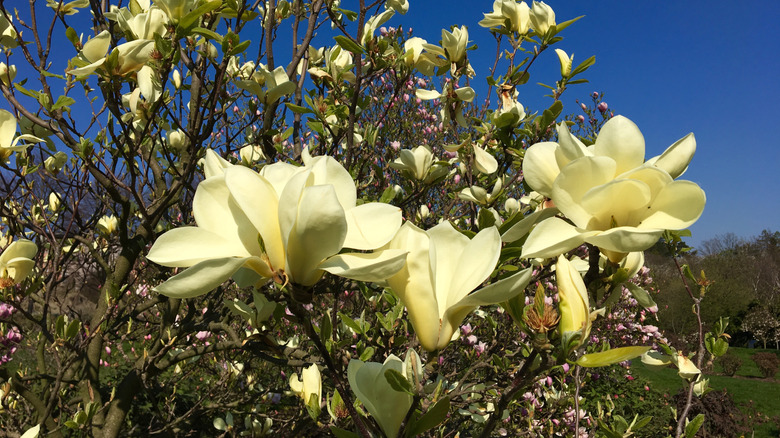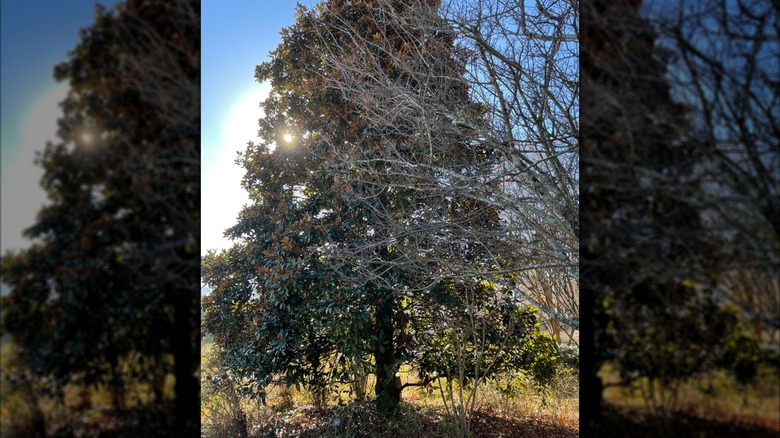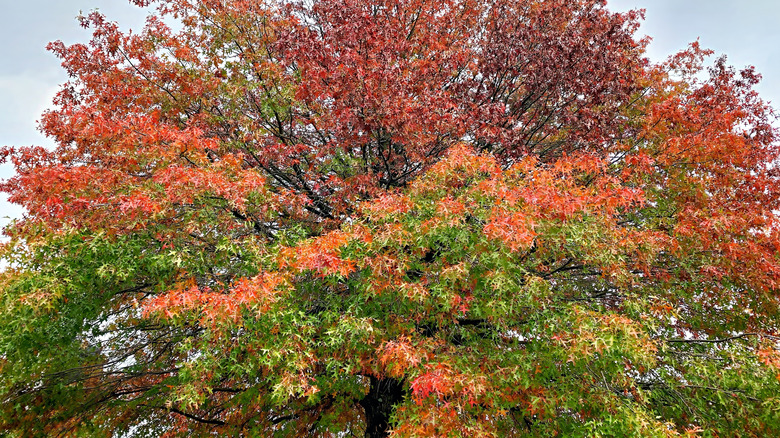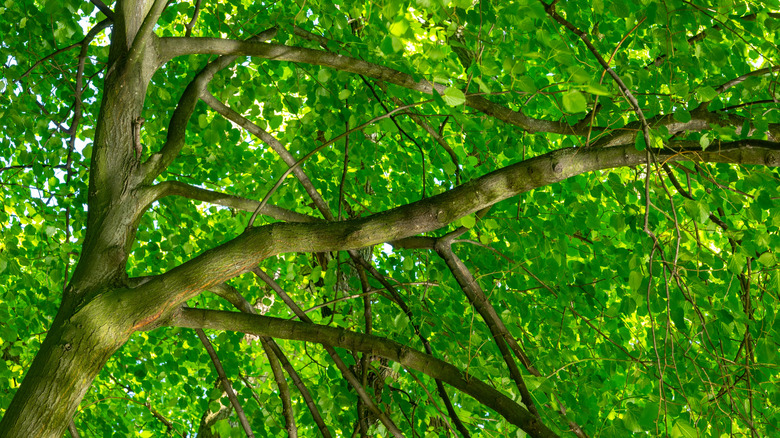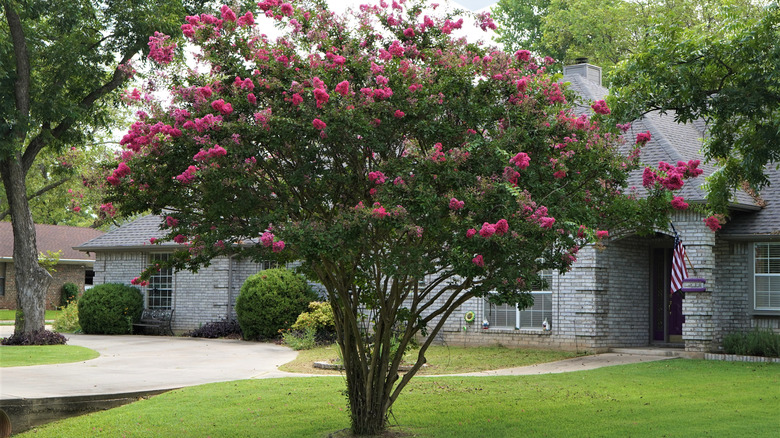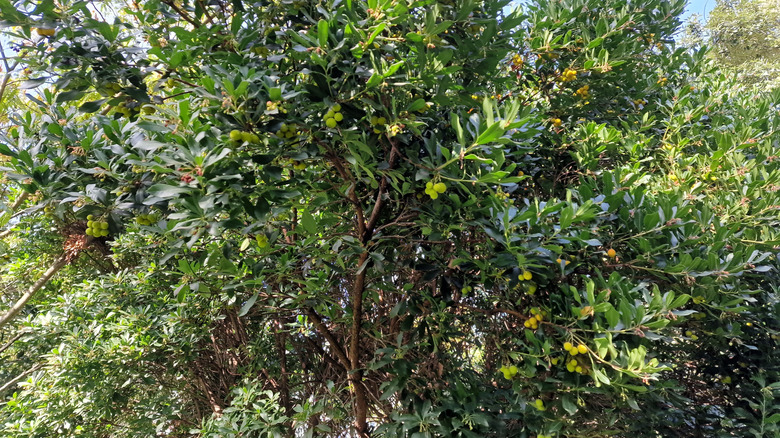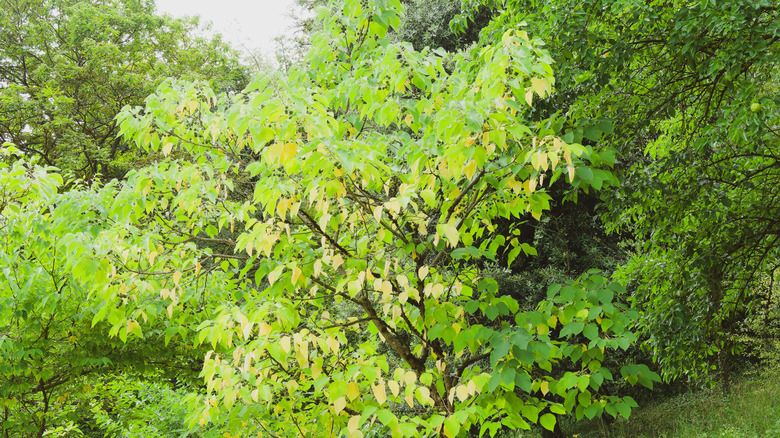18 Shade Trees That Can Handle High Temperatures And Cool Down A Yard
We may receive a commission on purchases made from links.
Shade trees address many modern homeownership and gardening woes. Through their sprawling mass of glossy leaves, they block the onslaught of sunlight, creating dedicated cool spots. They also cool themselves and the area around them through transpiration — a process where they release water from their leaves and tissues as vapor. Indeed, depending on how green (or concretized) these areas are, you can expect temperatures to fall by 10 to 16 degrees Fahrenheit, leading to energy savings of up to 30%. They also filter the air of dust and harmful pollutants, while checking erosion and water runoff through their extensive root systems.
But with climate projections indicating more frequent and intense heatwaves across many regions, not all shade trees can withstand high temperatures. Prolonged exposure to droughts might further compromise their thermal resilience. Don't worry — not all hope is lost. Plenty of trees, including maples, birches, magnolias, sweetgums, elms, and hackberries, can handle high temperatures and cool down a yard. For this to work, locate the trees away from concrete walkways that accelerate the "urban heat island" effect. Ensure their soils are adequately moist and mulched so the water lost through transpiration is timely replaced. Give their roots adequate room to spread and water consistently during the initial three growth years, or their heat resilience won't kick in. Depending on whether you require cooling during mornings or afternoons, plant your shade trees on the east and west sides, respectively. Here's a roundup of 18 heat-tolerant shade trees.
Temple of Bloom seven-son flower
Temple of Bloom seven-son flower (Heptacodium miconioides 'SMNHMRF') is a stunning new plant to add to your garden if you're seeking heat tolerance in a four-season small tree. As the summer winds down, it produces a mass of white flowers that drop off, exposing red bracts, and giving the impression of the multi-stemmed tree blooming in a different color altogether. Hummingbirds and butterflies enjoy their flowers, so site the specimen where you can watch them in action. Luckily, the 10-feet-wide trees are unfussy about soils. Part-to-full sun exposure in USDA zones 5 through 9 is ideal.
Golden rain tree
Golden rain trees (Koelreuteria paniculata) are a worthy addition to any urban yard. This is because their summer flowers blanket the ground after blooming, as if it has been rained on with gold-yellow petals. They exhibit tolerance to heat, drought, and pollution, while shading the yard with their 30-feet-wide canopy. They're also quite adaptable, putting their roots in all soils, from acidic to alkaline, to the extent of enduring occasional flooded and moist conditions. Owing to their self-seeding tendencies, they can grow weedy, so be sure to remove volunteers. They're invasive in parts of Virginia and Kentucky.
Crimson Sunset maple
Unlike many purple-leaved plants that grow stressed and fade away in summer heat, Crimson Sunset maple (Acer truncatum x Acer platanoides 'JFS-KW202'), a hybrid maple variety, can hold up really well in high temperatures. Plus, its regal display gets better with the fall, with its foliage assuming a stunning maroon overcoat. Fortunately, deer and diseases have little care for their leaves. Although Crimson Sunset can adapt to a wide range of conditions, it prefers moist and acidic soils. By maturity, it will cast a shade over a 20-foot-wide sunlit expanse.
Florida maple
Also called southern sugar maple, Florida maple (Acer floridanum) is another shade tree recognized for its heat tolerance, though a little hose of water in dry seasons is much appreciated. In addition, it displays forbearance against wind, frost, and ice, making it suitable in hurricane-prone areas of zones 6 through 9. Although you might not see much of their flowers, bees depend on them for early spring nectar. Florida maples turn a bright mix of orange and yellow in the fall, all the while supporting imperial moths' caterpillars and nesting birds with their foliage. They grow over 25 feet wide.
Chalk maple
Chalk, or whitebarked, maple (Acer leucoderme), is a small, drought-tolerant tree that can both take the hot summers of zone 9 and remain hardy through -20 degrees Fahrenheit. Above all, it can establish in diverse light conditions, from heavy shade to full sun, though you may need to water more in brightly-lit sites. It's a slow grower and gains over 25 feet in height by maturity, while the multi-stemmed trunk supports a 25-foot-wide rounded crown. You'll especially enjoy the vivid red fall colors. Butterflies will do the rounds of their flowers in early spring.
River birch
If you're looking for fast-growing trees that will thrive in damp soil (cue: muddy yard, around water features, or rain garden) and your area's hot summer, look no further than river birch (Betula nigra). It's the most heat-tolerant specimen of all birch trees, with trademarked cultivars like 'Dura-Heat' tolerating the southeast's heat, down to Florida. Although their canopy is over 40 feet wide by maturity, it isn't as dense. In other words, it'll survive if you would like to grass underneath the dappled shade. Keep away from hardscaping as the limbs are prone to breakage and can clutter the ground and drains.
Japanese plum yew
When you have a deeply or partially shaded site, frequently raided by deer, and exposed to hot and humid conditions (as is common to the southeast U.S.), plant Japanese plum yew (Cephalotaxus harringtonia) — it's a trooper in such tricky locations. It also features among the best trees to plant for privacy if you have a smaller backyard, given it approximates about 10 feet in height, albeit slightly wider. As it's also available in shrubby forms, ensure you've got the columnar form, like the Upright Japanese Plum Yew or 'Fastigiata.' Note that the plants are poisonous on consumption and can irritate the skin.
Farges filbert
Hailing from China, albeit non-invasive, Farges filbert (Corylus fargesii), or Chinese hazelnut is available as a grafted tree or propagated using seeds. A rapid grower, Farges filbert can extend nearly 40 feet wide in the landscape, lending ornamental appeal with its peeling bark. Since it blooms early in the spring, it helps the pollinators with nectar. Fruits are edible and can be stored for nearly a year for later consumption. Even trees as young as four years old can thrive in Georgia's summer heat, while being hardy to -20 degrees Fahrenheit. They're resistant to eastern blight and Japanese beetles.
Jacaranda
That jacaranda (Jacaranda mimosifolia) traces its origins to the tropical parts of South America should key you in about its heat tolerance. Withstanding temperatures to 100 degrees Fahrenheit, these drought-resistant trees can be grown in the sunny yards of Florida, Texas, and California. However, it's worth noting that they are cold-hardy only to 30 degrees Fahrenheit. While the purple blooms are lovely and enhance the curb appeal even after dropping, as they establish a carpet of purple underneath, they may feel messy and so must be sited carefully. They can extend nearly 25 feet wide and twice as high.
American sweetgum
Being native to the southeast U.S., American sweetgum (Liquidambar styraciflua) has developed resilience to 100 degrees Fahrenheit, though its performance takes a mild hit after breaching 93 degrees Fahrenheit. On the flip side, it's robust through zone 5, where mercury dives to -12 degrees Fahrenheit. However, young trees will need protection in sub-zero temperatures. Apart from its heat tolerance, sweetgum offers resistance to urban problems like compacted soils, poor watering, and fire. Playing larval host to moths and offering seeds to birds, this shade tree that can grow 40 feet wide provides immense wildlife benefits, albeit messily.
Black tupelo
Black tupelo (Nyssa sylvatica), or black gum, resists dry heat, drought stress, and fire in the southern states. It has also found many takers in coastal sites who appreciate its hardiness to salt sprays and wet soils. Black tupelo is also excellent for supporting native wildlife, with local and migratory birds stopping by for their berries and native bees getting sozzled on their flower nectar. Thankfully, deer steer clear of this wildlife party. While black tupelo trees can grow over 20 feet across and twice as tall, they're usually slow growers and will require proper care to encourage faster growth.
'Butterflies' magnolia
'Butterflies' magnolia (Magnolia 'Butterflies') trees are prized for their tulip-shaped yellow flowers that are in bloom from winter end to early spring, infusing the landscape with a pleasant citrus aroma. They retain ornamental value even after blooming, with their glossy green leaves throwing shade over 10 feet worth of ground after full growth. A hybrid variety, 'Butterflies' has nailed the art of tolerating cold winters of zone 5 and hot summers through zone 9. However, unless planted in a pollinator garden, don't expect it to produce fruits, as not many insects pollinate the flowers. Keep the roots mulched for moisture retention.
'Hasse' southern magnolia
For a heat-tolerant tree that you may tuck in narrow spaces, consider 'Hasse' southern magnolia (Magnolia grandiflora 'Hasse'). This is because its oval form usually stays under 10 feet wide. However, its surface roots can sprawl quite far out and require adequate room to enjoy the tree's best performance and drought tolerance. 'Hasse' is wonderful for the native wildlife because they enjoy the spring-summer blooms and fall's red seeds. Plant in full sun exposure if your watering game is on point. Otherwise, site in partial shade. Avoid growing it in the dry, alkaline soils of Texas and Oklahoma.
Scarlet oak
Naturally found in the dry Piedmont region, scarlet oak (Quercus coccinea) is another shade tree you may grow if you've the space to accommodate its 45-foot-wide and similarly tall frame. It can tolerate temperatures up to 105 degrees Fahrenheit, and is cold hardy to zone 4. As is typical for oaks, scarlet oak provides colossal benefits to a diverse wildlife. However, choose this fast-growing tree's location wisely, as its thin bark can fuel fire. Seeds and leaves can be mildly toxic to pets and humans on ingestion. Also, it can contract cankers, galls, oak wilt, and pests if not cared for properly.
American elm
If your area isn't frequented by bark beetles responsible for spreading the fatal Dutch elm disease, consider growing American elm (Ulmus americana). It can withstand summer temperatures of 95 degrees Fahrenheit and is appropriate for zones 3 through 9, including Texas and Florida. The double-serrated leathery leaves form a dense shade canopy that's about 30 feet wide. Compaction and drought won't usually stress established trees. Give them space in the butterfly garden, as a variety of species use their foliage for egg-laying. 'Valley Forge,' 'Princeton,' 'Jefferson,' and 'Deleware #2' exhibit decent disease resistance.
Crape myrtle
Crape myrtles (Lagerstroemia indica) thrive in hot summer climates. In fact, they take the mercury soaring past 85 degrees Fahrenheit as cues to flush flowers (usually July), with the show lasting for over two months. In short, if you live anywhere in zones 6 through 9, you can depend on crape myrtles to provide ample beauty and shade, especially when their dense canopies are overlooking patios or decks. Although they tolerate part-to-full shade, you'll maximize their performance and minimize disease outbreaks by siting them in full sun. Drought tolerance kicks in after two years of establishment; until then, water them well.
Strawberry tree
Strawberry tree (Arbutus unedo) is a popular tree for warm climates, especially around zones 6 through 9, because of its heat and drought tolerance. It also helps lower the temperatures with its leafy canopy that throws shade over a 15-foot-wide expanse. It's easy to grow, homing in a wide variety of soils, from mildly acidic to alkaline, sand to clay, and moist to intermittently dry. Hummingbirds, songbirds, and butterflies enjoy their fragrant flowers and red berries. Make sure to purchase varieties already trained into a tree form, or they'll grow shrubby. In limited spaces, consider short cultivars like 'Compacta' or 'Elfin King.'
Common hackberry
If you can accommodate a large tree in your yard, common hackberry (Celtis occidentalis) might be a suitable option. As it ages, its limbs arch down, creating a spreading canopy that expands nearly 50 feet in favorable conditions. Moreover, it can be planted anywhere in zones 3 through 9, given its tolerance for heat, drought, winds, ice, and urban settings. Birds love their fruits, especially as they remain suspended on the tree through the winter. However, the discarded seeds may create clutter, so avoid using them around walkways. Monitor the tree for cosmetic issues like witches' broom and powdery mildew.
